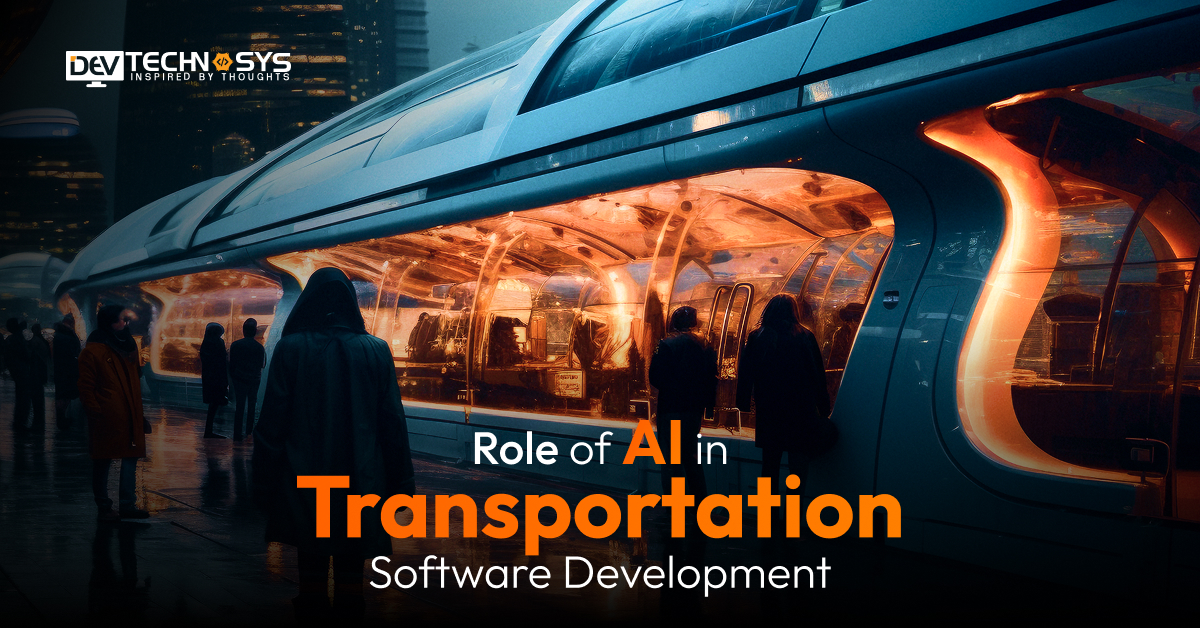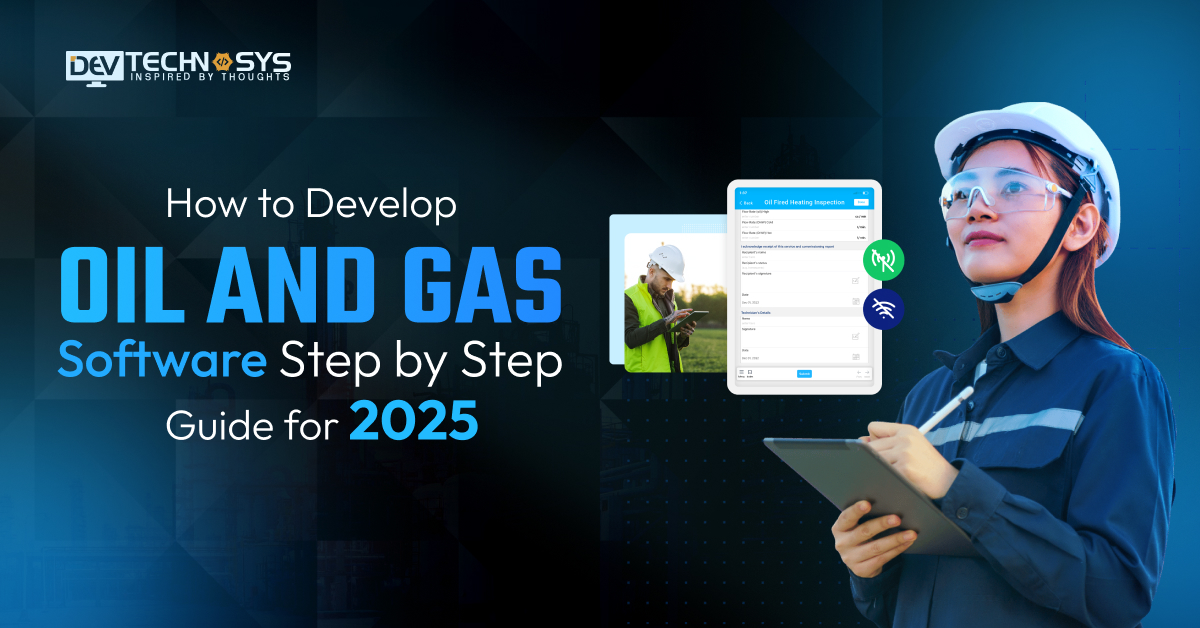In 2025, Artificial Intelligence (AI) is changing the way we travel and move things around.
From smart traffic lights to self-driving cars, AI is making transportation faster, safer, and more efficient.
I find it exciting to see how software powered by AI is helping to reduce traffic jams, prevent accidents, and even cut down pollution.
Developers are using AI to build smart transportation systems that can learn from real-time data and make quick decisions.
This helps buses, trains, and delivery trucks run on time. In the future, traveling will be easier and more comfortable because of AI.
Understanding the role of AI in transportation software development shows how technology is shaping a better world for everyone.
Let’s explore how AI is driving the future of transport in 2025!
The Global Projections of AI in Transportation Software Development
- The AI-powered transportation industry was assessed at USD 25–4.50 billion in 2023, rising to USD 21–35 billion by 2033–2034, with CAGRs ranging from 18.6% to 22.7% (depending on period and report.
- Software (e.g., fleet management, traffic systems, autonomous driving) typically has a 30-60% market share and a CAGR of 20-30% over the next 5
- With a market share of 38-50% and a CAGR of 22-25%, autonomous and semi-autonomous systems (ADAS, self-driving trucks/cars) dominate the application sector.
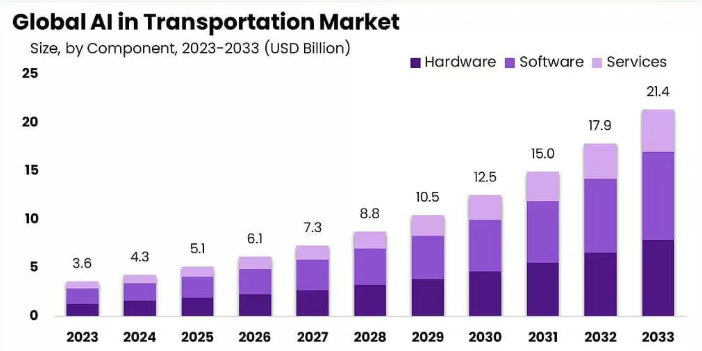
- By 2025, 50% of U.S. cars may have semi-autonomous technology. More than 15% of Chinese automobiles will have AI-driven semi-autonomous characteristics by 2023.
- By 2030, AI is expected to lower transportation costs by 5-10%, fuel consumption by 8-13%, and urban mobility CO₂ emissions by 225 million metric tons.
Metric |
Estimate / Forecast |
| 2023 Market Size | USD 3.25–4.5 B |
| Forecast by 2033–2034 | USD 21–35 B |
| CAGR (global) | ~18.6%–22.7% |
| Software Segment CAGR | ~20%–30% |
| Autonomous Systems Share | 38–50% |
| North America Market Share | 35–40% |
| APAC Market Share | 30–35% (fastest growth) |
| U.S. Semi-Autonomous Penetration | ~50% of vehicles by 2025 |
| Firm Adoption Rates | ~33% adopted AI; 87% use predictive analytics |
| Cost Savings | 5–10%; Fuel savings 8–13%; CO₂ ↓ 225M MT by 2030 |
Role of AI in Transportation Software Development
AI is revolutionizing transportation software development services by enabling smarter route planning, autonomous vehicle control, predictive maintenance, and real-time traffic management. In 2025, AI-driven systems will enhance efficiency, safety, and sustainability across logistics, public transit, and urban mobility solutions.
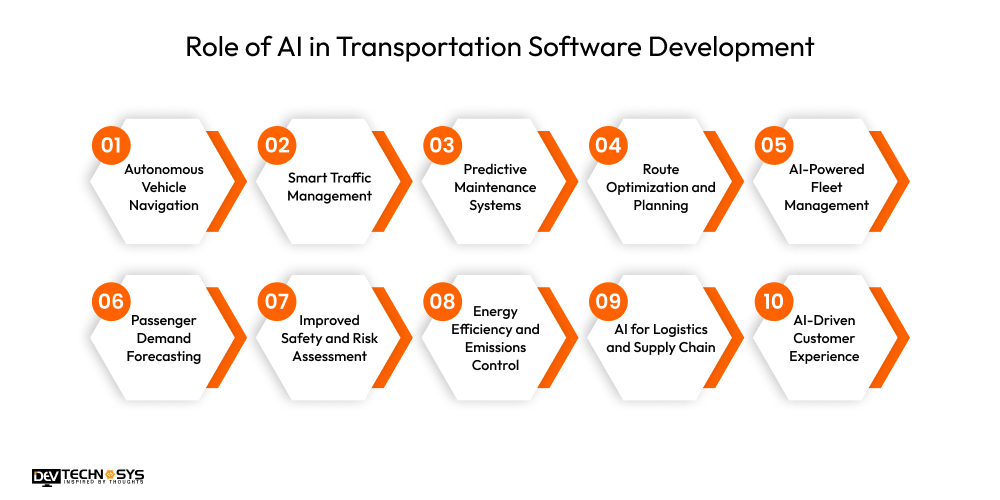
1. Autonomous Vehicle Navigation
AI fuels self-driving vehicles with powerful algorithms that evaluate sensor data in real time, allowing for safe and precise navigation. AI models are currently being used in transportation software to detect obstacles, design routes, and make decisions under a variety of traffic scenarios.
This technology eliminates human error and improves traffic safety, representing a dramatic shift in how vehicles function autonomously in both urban and highway settings.
2. Smart Traffic Management
If businesses develop transportation software with AI implementation, it provides dynamic traffic control systems that respond in real-time to congestion and incidents. AI-powered software can optimize signal timing, redirect traffic, and forecast peak hours by studying real-time traffic.
This minimizes transportation delays, increases fuel efficiency, and helps cities manage growing urban mobility challenges, all while reducing environmental impact and infrastructure stress.
3. Predictive Maintenance Systems
AI in transportation and logistics analyzes vehicle and equipment performance in order to identify possible issues before they occur. It uses machine learning and historical data to anticipate wear and tear tendencies.
This reduces downtime, lowers repair costs, and improves operational efficiency across fleets, particularly in logistics and public transportation, where maintenance delays may seriously disrupt schedules..
4. Route Optimization and Planning
AI algorithms improve route planning by evaluating traffic, weather, road conditions, and delivery timetables. Transportation software selects the quickest, safest, and most fuel-efficient routes based on real-time data.
This not only lowers delivery times but also decreases gasoline usage and carbon emissions, providing economic and environmental benefits to both logistics businesses and commuters.
5. AI-Powered Fleet Management
AI is being used extensively in fleet management platforms for vehicle monitoring, driver behavior analysis, and operational planning. AI enables managers to better allocate resources, anticipate vehicle performance issues, and reduce fuel consumption.
AI integration in fleet systems enhances decision-making, optimizes asset utilization, and ensures regulatory compliance with safety and pollution regulations.
6. Passenger Demand Forecasting
AI in public transportation estimates passenger demand patterns based on historical data, weather, and special events. This enables transportation providers to change timetables and dispatch cars more effectively. It improves service availability during peak hours, shortens wait times, and enables smarter urban transportation planning that responds to changing user behavior in real time.
7. Improved Safety and Risk Assessment
AI systems analyze driving behavior, vehicle circumstances, and ambient elements to detect safety hazards in real time. These insights are used by transportation software to provide alerts or automated responses, such as emergency braking.
This proactive method reduces accidents, protects drivers and passengers, and enables insurance companies to better assess risk and enhance claim processing accuracy.
8. Energy Efficiency and Emissions Control
AI-powered software improves energy efficiency by optimizing fuel use, vehicle load distribution, and driving behaviors. AI can assist control battery performance and charging schedules in electric car fleets.
These enhancements considerably cut operating emissions, aligning with global sustainability goals and promoting greener transportation systems in both the commercial and governmental sectors.
9. AI for Logistics and Supply Chain
In logistics, AI improves software platforms for inventory tracking, warehouse management, and shipping scheduling. Machine learning algorithms predict demand, alter supply schedules, and automate dispatch procedures.
These enhancements enable firms to minimize stockouts, cut delivery costs, and give real-time insight throughout supply chains, therefore improving overall resilience and customer happiness.
10. AI-Driven Customer Experience
AI improves the end-user experience by providing chatbots, real-time trip information, and tailored services in transportation apps. AI offers speedier issue resolution, precise ETAs, and dynamic pricing models across ride-hailing, public transportation, and delivery systems.
These changes boost user pleasure, encourage app engagement, and set service providers up for long-term commitment and success.
7 Real-World Examples: Use AI in Transportation
Discover how AI is revolutionizing transportation worldwide through smart traffic management, autonomous vehicles, predictive maintenance, and optimized logistics, enhancing safety, efficiency, and sustainability across cities, airports, and public transit systems globally.
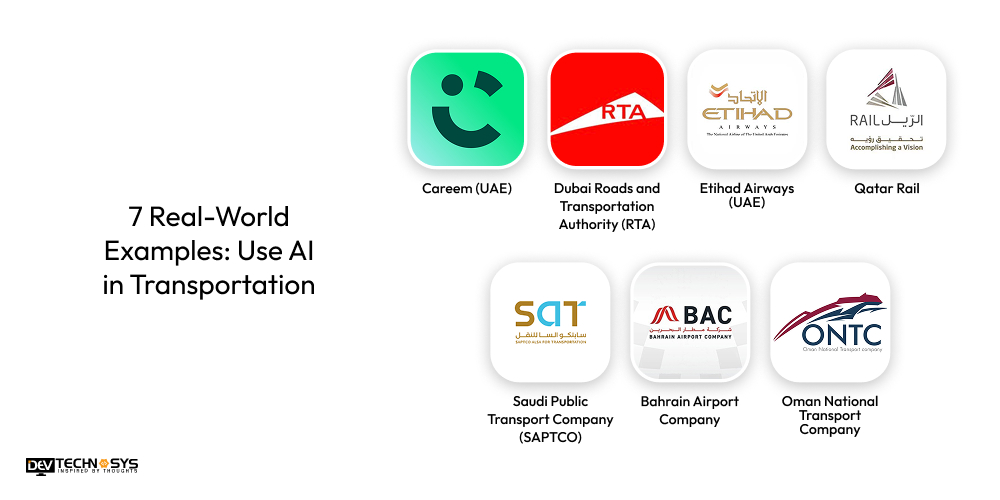
1. Careem (UAE)
Careem uses AI to improve its ride-hailing services by improving ride matching, dynamic pricing, and route planning. Their AI algorithms assess real-time traffic, consumer demand, and driver locations, resulting in speedier pickups and more efficient journeys.
This technique lowers wait times and operating expenses while increasing client happiness. Careem’s AI-powered insights also aid in increasing service coverage and projecting demand patterns, so making urban transportation smarter in diverse Middle Eastern cities.
2. Dubai Roads and Transportation Authority (RTA)
The Dubai RTA uses AI technology to improve urban mobility by controlling traffic congestion using smart traffic signals and predictive analytics. The AI technology automatically modifies traffic light timings in response to real-time traffic flow, weather, and events, dramatically decreasing congestion and accidents.This automated traffic management minimizes carbon emissions while improving the passenger experience.
3. Etihad Airways (UAE)
Etihad Airways uses AI-powered predictive maintenance solutions to improve aircraft safety and operational efficiency. Etihad uses sensor data and machine learning algorithms to monitor airplane components in real-time, detecting possible issues before they occur. This proactive maintenance technique shortens flight delays, minimizes maintenance costs, and enhances passenger safety.
4. Qatar Rail
Qatar Rail uses AI technology in its metro and rail systems for real-time monitoring, predictive maintenance, and passenger flow management. AI uses sensor and ticketing data to discover issues early, plan timely repairs, and modify train frequency based on demand. These AI-driven enhancements increase dependability, safety, and efficiency, particularly during peak traffic periods like international events.
5. Saudi Public Transport Company (SAPTCO)
Uses AI to optimize bus routes and timetables in Saudi Arabia. Their artificial intelligence algorithms assess passenger demand, traffic conditions, and operational data to improve service efficiency and cut trip times. AI-driven scheduling responds dynamically to varying passenger flows, ensuring that buses operate at full capacity.
6. Bahrain Airport Company
The airport uses AI-based monitoring and passenger flow management to improve security and efficiency. AI-powered video analytics detect suspicious activity and abnormalities in real time, which improves threat detection. Furthermore, AI aids with passenger queue management by forecasting peak periods and changing staffing and resources appropriately.
7. Oman National Transport Company
Utilizes AI for fleet management and predictive maintenance of public buses. AI analyzes car data to predict mechanical difficulties, plan maintenance in advance, and optimize fuel use. Furthermore, AI aids in route planning by taking into account traffic patterns and passenger demand, therefore improving service dependability and lowering operating costs.
Benefits of AI in Transportation Software
Artificial Intelligence (AI) is rapidly transforming transportation software, offering many benefits that improve how vehicles and transportation systems operate. Here are five key advantages of using artificial intelligence in transportation software:

1. Optimal Route Planning
AI-powered systems use real-time traffic data, weather conditions, and road closures to determine the most efficient routes. This reduces travel time, fuel consumption, and pollutants. For logistics businesses, this implies speedier delivery and cheaper operational expenses.
2. Predictive Maintenance
AI systems can analyze sensor data and historical trends to forecast when a vehicle or machine part may break. This enables prompt maintenance, reducing costly failures and downtime. Predictive maintenance improves vehicle dependability and prolongs its lifespan.
3. Enhanced Safety
AI improves safety by powering driver assistance systems and self-driving automobiles. Features like as collision detection, lane departure alerts, and autonomous braking help to prevent accidents due by human error. According to the custom software development company, AI can also track driver behavior to encourage safer driving habits.
4. Traffic Management
Cities employ artificial intelligence to regulate traffic flow more effectively. AI can use data from cameras, sensors, and GPS to dynamically manage traffic lights, alleviate congestion, and optimize public transit timetables. This saves time in traffic and reduces pollutant levels.
5. Improved Passenger Experience
The impact of AI in transportation improves the travel experience by providing tailored services like smart ticketing, real-time information, and customer assistance via chatbots. It may also assess customer preferences to enhance transportation planning and services, resulting in more comfortable and convenient trips.
Challenges and Solutions for Using AI in Transportation Software Development
Explore key challenges in AI logistics software development, including data quality, legacy system integration, real-time processing, safety, and privacy concerns. Discover practical solutions like robust data management, modular design, edge computing, rigorous testing, and ethical practices to ensure efficient, reliable, and secure AI-powered transportation systems.
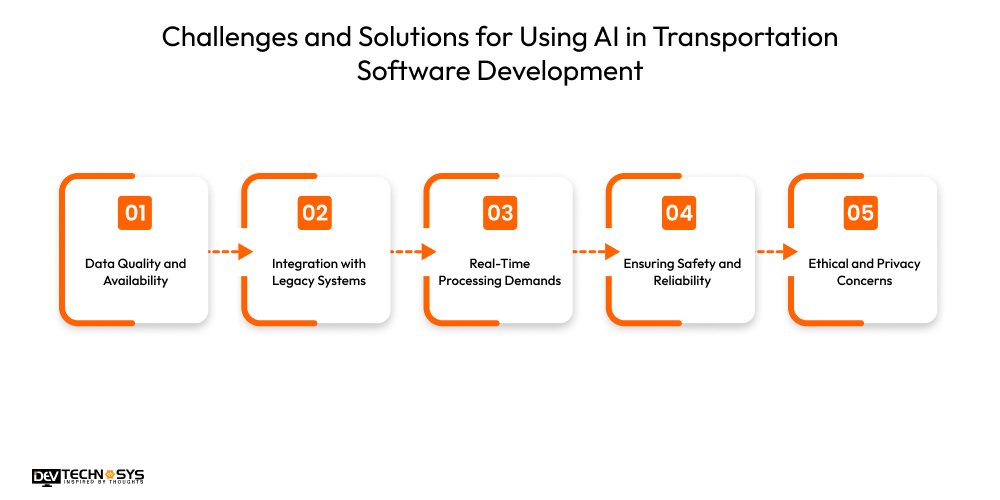
1. Data Quality and Availability
Challenge: Transportation AI requires vast, high-quality data, which can be fragmented or incomplete.
Solution: Implement robust data collection systems, use data augmentation, and apply cleaning techniques to ensure accurate, comprehensive datasets, enabling reliable AI model training and better decision-making.
2. Integration with Legacy Systems
Challenge: Existing transportation infrastructure often relies on outdated software, complicating AI integration.
Solution: Develop modular AI solutions with APIs for seamless integration, gradually modernize legacy systems, and ensure backward compatibility to enhance AI adoption without disrupting operations.
3. Real-Time Processing Demands
Challenge: Transportation applications need rapid, real-time AI processing for traffic or safety management.
Solution: Utilize edge computing and optimized algorithms to process data locally and efficiently, reducing latency and improving response times for critical, time-sensitive decisions.
4. Ensuring Safety and Reliability
Challenge: AI errors in transportation can cause accidents or system failures.
Solution: Incorporate rigorous testing, continuous monitoring, and fail-safe mechanisms. Combine AI insights with human oversight to maintain high safety standards and build trust in AI-driven systems.
5. Ethical and Privacy Concerns
Challenge: AI systems collect sensitive data, raising privacy and ethical issues.
Solution: A software development company Dubai implements strict data privacy protocols, anonymizes user data, ensures compliance with regulations, and maintains transparency about AI usage to safeguard user rights and build public confidence.
10 Use Cases of AI in Transportation Software Development
AI is transforming transportation software by helping to find the best routes, predict and prevent vehicle breakdowns, support self-driving cars, manage traffic flow, and enhance safety for passengers. These improvements make travel faster, safer, and more efficient, benefiting drivers, passengers, and transportation companies alike.
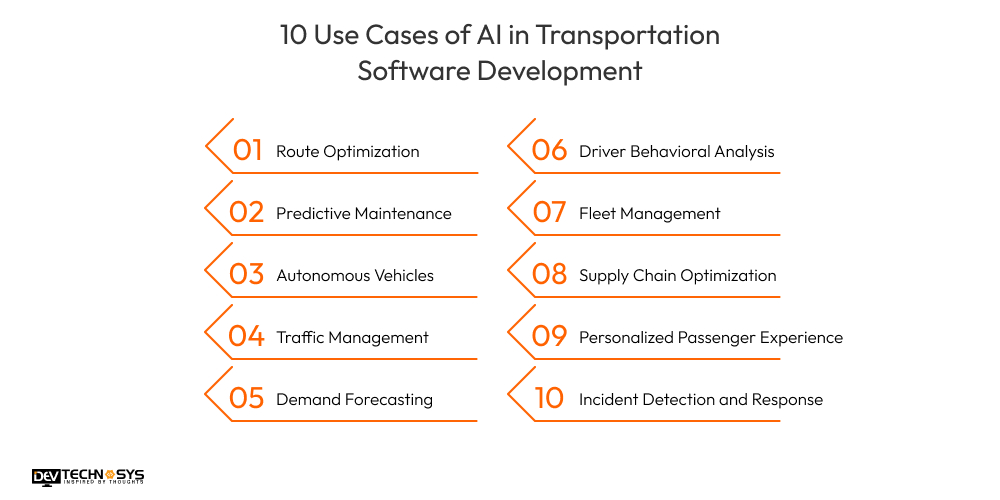
1. Route Optimization
AI analyzes real-time data like as traffic, weather, and road conditions to find the most efficient routes. This minimizes travel time, fuel consumption, and operating costs while boosting logistics and ride-sharing services through dynamic, adaptive routing depending on current conditions, resulting in increased overall transportation efficiency.
2. Predictive Maintenance
AI regularly monitors vehicle performance data to anticipate probable issues before they occur. This proactive maintenance technique eliminates unexpected failures, decreases repair costs, and improves fleet dependability by scheduling maintenance based on real vehicle conditions rather than predetermined intervals, therefore improving vehicle uptime and safety.
3. Autonomous Vehicles
AI supports self-driving cars by digesting sensor data, mapping surroundings, and making real-time judgments. This technology improves road safety, minimizes human error, and provides efficient, scalable transportation solutions that do not require human drivers, changing urban mobility and logistics.
4. Traffic Management
Application of AI in transportation monitors traffic flow patterns and automatically change traffic signals to reduce congestion. This adaptive management decreases travel delays, lowers emissions, and enhances urban mobility by responding to changing traffic circumstances in real time, so improving road safety and efficiency.
5. Demand Forecasting
AI algorithms employ historical and real-time data to properly forecast passenger or freight demand. This allows transportation companies to improve resource allocation, scheduling, and capacity planning, lowering costs and increasing service quality by properly matching supply to projected demand.
6. Driver Behavioral Analysis
AI applications in transportation industry analyze driver actions to detect potentially dangerous behaviors like as forceful braking, speeding, or weariness. Providing feedback and warnings improves safety, lowers accident rates, and promotes improved driving behaviors, all of which contribute to total fleet safety and compliance.
7. Fleet Management
On-demand shipping and trucking monitors vehicle position, fuel use, and maintenance requirements in real time. This complete supervision streamlines fleet operations, maximizes asset usage, lowers operating costs, and enhances service delivery by allowing for data-driven decision-making.
8. Supply Chain Optimization
AI analyzes supply chain data to improve delivery routes, inventory levels, and warehouse efficiency. This lowers delays, saves money, and improves overall logistics efficiency by enhancing coordination between transportation, storage, and distribution activities.
9. Personalized Passenger Experience
AI uses user data to personalize travel alternatives, ticket prices, and onboarding services. Personalization boosts consumer happiness by tailoring suggestions, discounts, and seamless service experiences to individual preferences and travel history.
10. Incident Detection and Response
Artificial intelligence systems use sensors and cameras to identify accidents, road dangers, and unexpected events in real-time. An artificial intelligence development company enables faster emergency responses, eliminates traffic interruptions, and enhances overall road safety by mitigating the impact of events on traffic flow.
AI Technologies Are Used in Transportation
AI is transforming transportation with technologies like machine learning, deep learning, computer vision, and NLP. These enable autonomous vehicles, smart traffic control, predictive maintenance, route optimization, and enhanced passenger services, making systems safer, faster, and more efficient.
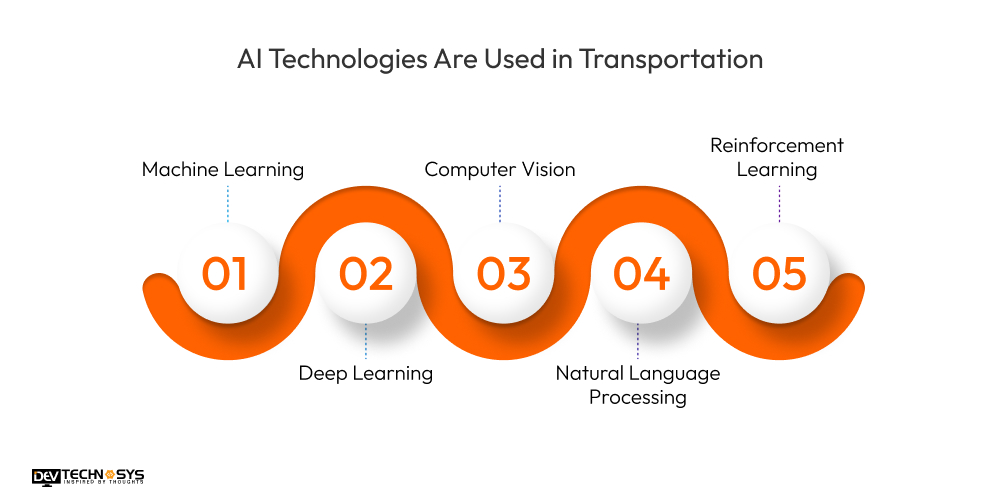
1. Machine Learning
Machine learning improves route planning, traffic prediction, and vehicle maintenance. ML models use historical and real-time data to estimate traffic congestion, increase fuel economy, and optimize delivery schedules. It also drives adaptive traffic signals, demand forecasts, and driving behavior analysis, making transportation systems more intelligent and efficient.
2. Deep Learning
Deep learning uses neural networks to achieve high-accuracy sensing in autonomous cars. It enables image recognition for lane detection, pedestrian tracking, and obstacle avoidance. Deep learning models can also handle complicated traffic patterns, improve safety systems, and aid in end-to-end autonomous driving decision-making using real-time sensor and video data.
3. Computer Vision
Computer vision enables cars and traffic systems to “see” their surroundings. It is used to identify objects, recognize license plates, and monitor traffic. It is used by self-driving cars to identify hazards, recognize signs, and maintain lane boundaries.
According to the mobile app development services provider, it also improves surveillance, toll collecting, and parking management by utilizing real-time video analytics and image processing.
4. Natural Language Processing
NLP powers voice assistants in cars, chatbot customer support for transit systems, and automated translation in international transportation hubs. It aids in processing driver commands, coordinating logistics communication, and collecting insights from transport documentation. NLP also supports speech-to-text systems, allowing for hands-free navigation and real-time updates in smart mobility apps.
5. Reinforcement Learning
Reinforcement learning (RL) trains systems to make consecutive judgments, making it perfect for tasks such as autonomous driving, traffic light management, and drone navigation. RL improves activities by learning from interactions with the environment, resulting in increased safety and efficiency.It adjusts to changing traffic circumstances, assists in fleet management, and aids in course planning in unpredictable environments.
Future of AI in Transportation Software
The future of AI in transportation software development includes fully autonomous vehicles, smart traffic management for reduced congestion, and personalized travel experiences that improve safety, efficiency, and convenience for all users.

1. Smart Traffic Systems
Future AI-powered traffic management systems will employ real-time data and predictive analytics to dynamically regulate traffic signals, minimize congestion, and improve public transportation routes. This will result in better traffic flow, reduced pollution, and quicker commutes, particularly in developing metropolitan regions where regulating transportation demand is crucial.
2. Autonomous Vehicles Expansion
If businesses build an transportation app like Aramex, the AI will accelerate the growth as completely driverless vehicles, making them safer and more dependable. Advanced artificial intelligence systems will manage complicated driving settings, eliminate human error, and transform logistics and personal travel by allowing large-scale, hands-free mobility.
3. Personalized Travel Experiences
AI will provide highly tailored transportation services based on individual preferences, travel history, and real-time circumstances. From personalized route suggestions to adaptive scheduling and seamless multi-modal travel alternatives, AI will make transportation more convenient, accessible, and user-friendly, increasing overall passenger happiness and efficiency.
Conclusion
In 2025, AI will continue to revolutionize the transportation industry, driving innovation and efficiency in every aspect of software development. For any transportation software development company, embracing AI means delivering smarter, safer, and more adaptive solutions that meet the evolving demands of mobility.
As AI-powered technologies become integral, companies that harness this potential will lead the market, creating seamless experiences and transforming how people and goods move. The future of transportation software is undeniably AI-driven, shaping smarter journeys and smarter cities worldwide.
Frequently Asked Questions
1. How is AI Used in Transportation?
AI is used in transportation for autonomous vehicles, traffic management, predictive maintenance, route optimization, demand forecasting, and safety systems, enhancing efficiency, reducing costs, and improving overall mobility and safety.
2. What Types Of AI Technologies Are Commonly Used In Transportation?
Common AI technologies used in transportation include machine learning, deep learning, computer vision, natural language processing, and reinforcement learning. These enable predictive analytics, autonomous driving, traffic management, route optimization, and intelligent decision-making across systems.
3. Are AI Algorithms Used For Driver Behavior Analysis?
Yes, AI algorithms analyze driver behavior using data from sensors and cameras to detect patterns such as fatigue, distraction, speed, and braking habits, helping improve road safety, provide feedback, and reduce accident risks.
4. How Much Does It Cost to Implement AI in Transportation?
The cost to implement AI in transportation varies widely, ranging from $12,000 to several million dollars, depending on project scope, infrastructure needs, data integration, software complexity, and ongoing maintenance requirements.
5. How is AI Integrated Into Transportation Apps?
AI in transportation apps powers real-time navigation, traffic prediction, ride-sharing optimization, route planning, user behavior analysis, and voice assistance, enhancing efficiency, safety, personalization, and overall user experience.



